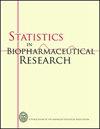Rejoinder to Comments on “Non-Proportional Hazards – An Evaluation of the MaxCombo Test in Cancer Clinical Trials”
IF 1.5
4区 医学
Q3 MATHEMATICAL & COMPUTATIONAL BIOLOGY
引用次数: 0
Abstract
This rejoinder continues a discussion initiated by the Oncology Center of Excellence’s call (2016–2017) for statistical approaches to address the problem of assessing treatment effects in the presence of non-proportional hazards (NPH) (Duke-Margolis Workshop 2018; Lin et al. 2020a, Lin et al. 2020b; Roychoudhury et al. 2021). The publication of the method was met with much discussion, several commentary articles (Freidlin and Korn 2019; Bartlett et al. 2020; Lin et al. 2020a; Magirr and Burman 2021; Roychoudhury et al. 2021) and a rejoinder by the MaxCombo test coauthors (Lin et al. 2020b). After consideration of the proposed method and review of its accompanying responses and rejoinder, we expressed our views on the MaxCombo tests and provided general thoughts on design issues when NPH is expected in our article (Shen et al. 2021). In response to the publication of our article, the Cross-PhRMA working group (Lin et al. 2023) and Posch, Ristl, and König (2022) published additional commentary providing further clarification and views. We appreciate the great interest in NPH issues in the regulatory statistical community and would like to take this opportunity to provide additional clarifications and comments. Although the primary objective of our 2021 article was to focus on the MaxCombo test, as noted by Lin et al. (2023), a number of the issues are more general and are equally applicable when using many other methods and testing statistics, for example, the difficulty in interpretation or failure to incorporate underlying reasons of NPH. In fact, recognizing the shortcomings of the more commonly used tests such as log-rank test, etc., FDA initiated the dialogue and invited PhRMA to come together to develop methodology to address this issue. The MaxCombo test is presented as representing a flexible testing procedure impervious to a variety of shapes of curves under NPH. Cross-PhRMA working group suggested a 3-step method for evaluation of treatment effect when NPH is expected (Lin et al. 2020a, Lin et al. 2020b, Roychoudhury et al. 2021). Lin et al. (2023) clarified that in this scenario, a successful treatment effect would not be claimed based solely on results from the MaxCombo test, as the Cross-PhRMA working group recommends such decisions be based on the totality of data对“非比例风险——对MaxCombo试验在癌症临床试验中的评价”评论的答复
该反驳继续了肿瘤卓越中心(2016-2017)发起的关于统计方法的讨论,以解决在存在非比例风险(NPH)的情况下评估治疗效果的问题(Duke-Margolis Workshop 2018;Lin et al. 2020a, Lin et al. 2020b;Roychoudhury et al. 2021)。该方法的发表引起了很多讨论,几篇评论文章(Freidlin and Korn 2019;Bartlett et al. 2020;Lin等。2020a;Magirr and Burman 2021;Roychoudhury等人,2021)和MaxCombo测试合著者的反驳(Lin等人,2020b)。在考虑了提议的方法并审查了相关的回应和反驳后,我们在文章中表达了我们对MaxCombo测试的看法,并就NPH预期时的设计问题提供了总体思路(Shen et al. 2021)。作为对我们文章发表的回应,Cross-PhRMA工作组(Lin et al. 2023)、Posch、Ristl和König(2022)发表了额外的评论,提供了进一步的澄清和观点。我们感谢监管统计界对NPH问题的极大兴趣,并希望借此机会提供额外的澄清和评论。正如Lin等人(2023)所指出的,尽管我们2021年文章的主要目标是关注MaxCombo测试,但许多问题更为普遍,在使用许多其他方法和测试统计数据时同样适用,例如,难以解释或未能纳入NPH的潜在原因。事实上,认识到更常用的测试(如log-rank测试等)的缺点,FDA发起了对话,并邀请PhRMA一起制定解决这一问题的方法。MaxCombo测试代表了一种灵活的测试程序,不受NPH下各种形状曲线的影响。跨phrma工作组提出了一种评估NPH预期治疗效果的三步法(Lin et al. 2020a, Lin et al. 2020b, Roychoudhury et al. 2021)。Lin等人(2023)澄清说,在这种情况下,不能仅仅根据MaxCombo测试的结果来宣称成功的治疗效果,因为Cross-PhRMA工作组建议基于整体数据做出此类决定
本文章由计算机程序翻译,如有差异,请以英文原文为准。
求助全文
约1分钟内获得全文
求助全文
来源期刊

Statistics in Biopharmaceutical Research
MATHEMATICAL & COMPUTATIONAL BIOLOGY-STATISTICS & PROBABILITY
CiteScore
3.90
自引率
16.70%
发文量
56
期刊介绍:
Statistics in Biopharmaceutical Research ( SBR), publishes articles that focus on the needs of researchers and applied statisticians in biopharmaceutical industries; academic biostatisticians from schools of medicine, veterinary medicine, public health, and pharmacy; statisticians and quantitative analysts working in regulatory agencies (e.g., U.S. Food and Drug Administration and its counterpart in other countries); statisticians with an interest in adopting methodology presented in this journal to their own fields; and nonstatisticians with an interest in applying statistical methods to biopharmaceutical problems.
Statistics in Biopharmaceutical Research accepts papers that discuss appropriate statistical methodology and information regarding the use of statistics in all phases of research, development, and practice in the pharmaceutical, biopharmaceutical, device, and diagnostics industries. Articles should focus on the development of novel statistical methods, novel applications of current methods, or the innovative application of statistical principles that can be used by statistical practitioners in these disciplines. Areas of application may include statistical methods for drug discovery, including papers that address issues of multiplicity, sequential trials, adaptive designs, etc.; preclinical and clinical studies; genomics and proteomics; bioassay; biomarkers and surrogate markers; models and analyses of drug history, including pharmacoeconomics, product life cycle, detection of adverse events in clinical studies, and postmarketing risk assessment; regulatory guidelines, including issues of standardization of terminology (e.g., CDISC), tolerance and specification limits related to pharmaceutical practice, and novel methods of drug approval; and detection of adverse events in clinical and toxicological studies. Tutorial articles also are welcome. Articles should include demonstrable evidence of the usefulness of this methodology (presumably by means of an application).
The Editorial Board of SBR intends to ensure that the journal continually provides important, useful, and timely information. To accomplish this, the board strives to attract outstanding articles by seeing that each submission receives a careful, thorough, and prompt review.
Authors can choose to publish gold open access in this journal.
 求助内容:
求助内容: 应助结果提醒方式:
应助结果提醒方式:


